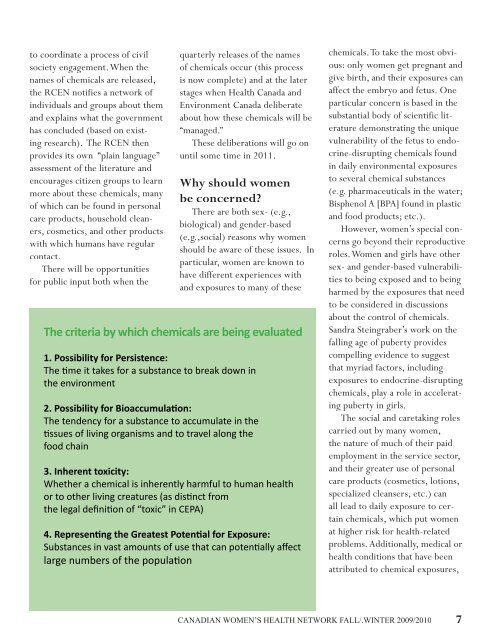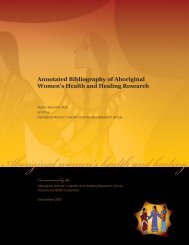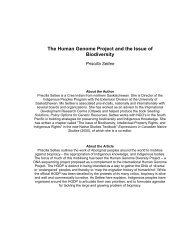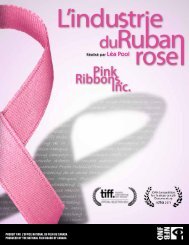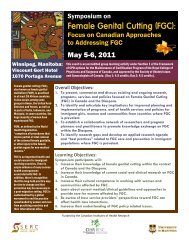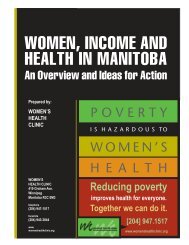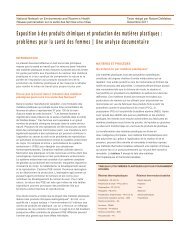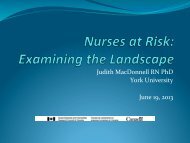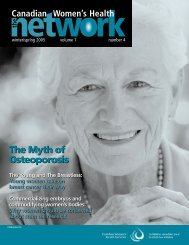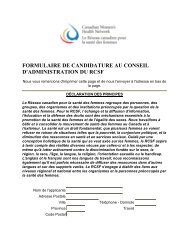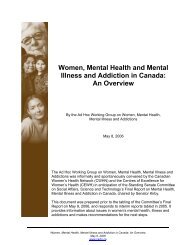Network 12-1.pdf - Canadian Women's Health Network
Network 12-1.pdf - Canadian Women's Health Network
Network 12-1.pdf - Canadian Women's Health Network
You also want an ePaper? Increase the reach of your titles
YUMPU automatically turns print PDFs into web optimized ePapers that Google loves.
to coordinate a process of civil<br />
society engagement. When the<br />
names of chemicals are released,<br />
the RCEN notifies a network of<br />
individuals and groups about them<br />
and explains what the government<br />
has concluded (based on existing<br />
research). The RCEN then<br />
provides its own “plain language”<br />
assessment of the literature and<br />
encourages citizen groups to learn<br />
more about these chemicals, many<br />
of which can be found in personal<br />
care products, household cleaners,<br />
cosmetics, and other products<br />
with which humans have regular<br />
contact.<br />
There will be opportunities<br />
for public input both when the<br />
quarterly releases of the names<br />
of chemicals occur (this process<br />
is now complete) and at the later<br />
stages when <strong>Health</strong> Canada and<br />
Environment Canada deliberate<br />
about how these chemicals will be<br />
“managed.”<br />
These deliberations will go on<br />
until some time in 2011.<br />
Why should women<br />
be concerned?<br />
There are both sex- (e.g.,<br />
biological) and gender-based<br />
(e.g.,social) reasons why women<br />
should be aware of these issues. In<br />
particular, women are known to<br />
have different experiences with<br />
and exposures to many of these<br />
The criteria by which chemicals are being evaluated<br />
1. Possibility for Persistence:<br />
The me it takes for a substance to break down in<br />
the environment<br />
2. Possibility for Bioaccumulaon:<br />
The tendency for a substance to accumulate in the<br />
ssues of living organisms and to travel along the<br />
food chain<br />
3. Inherent toxicity:<br />
Whether a chemical is inherently harmful to human health<br />
or to other living creatures (as disnct from<br />
the legal definion of “toxic” in CEPA)<br />
4. Represenng the Greatest Potenal for Exposure:<br />
Substances in vast amounts of use that can potenally affect<br />
large numbers of the populaon<br />
chemicals. To take the most obvious:<br />
only women get pregnant and<br />
give birth, and their exposures can<br />
affect the embryo and fetus. One<br />
particular concern is based in the<br />
substantial body of scientific literature<br />
demonstrating the unique<br />
vulnerability of the fetus to endocrine-disrupting<br />
chemicals found<br />
in daily environmental exposures<br />
to several chemical substances<br />
(e.g. pharmaceuticals in the water;<br />
Bisphenol A [BPA] found in plastic<br />
and food products; etc.).<br />
However, women’s special concerns<br />
go beyond their reproductive<br />
roles. Women and girls have other<br />
sex- and gender-based vulnerabilities<br />
to being exposed and to being<br />
harmed by the exposures that need<br />
to be considered in discussions<br />
about the control of chemicals.<br />
Sandra Steingraber’s work on the<br />
falling age of puberty provides<br />
compelling evidence to suggest<br />
that myriad factors, including<br />
exposures to endocrine-disrupting<br />
chemicals, play a role in accelerating<br />
puberty in girls.<br />
The social and caretaking roles<br />
carried out by many women,<br />
the nature of much of their paid<br />
employment in the service sector,<br />
and their greater use of personal<br />
care products (cosmetics, lotions,<br />
specialized cleansers, etc.) can<br />
all lead to daily exposure to certain<br />
chemicals, which put women<br />
at higher risk for health-related<br />
problems. Additionally, medical or<br />
health conditions that have been<br />
attributed to chemical exposures,<br />
CANADIAN WOMEN’S HEALTH NETWORK FALL/.WINTER 2009/2010 7


